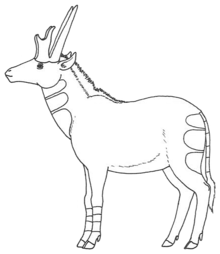Hayoceros
Hayoceros is an extinct genus of the artiodactyl family Antilocapridae, endemic to North America during the Early Pleistocene epoch (1.8 mya—300,000 years ago), existing for about 1.5 million years.[1]
| Hayoceros Temporal range: Mid Pleistocene | |
|---|---|
 | |
| Scientific classification | |
| Kingdom: | Animalia |
| Phylum: | Chordata |
| Class: | Mammalia |
| Order: | Artiodactyla |
| Family: | Antilocapridae |
| Genus: | †Hayoceros Skinner, 1942 |
| Species | |
| |
Taxonomy
Hayoceros was named by Skinner (1942) and named as a subgenus of Tetrameryx by Frick 1937; it was later raised to genus level. It was assigned to the Antilocapridae by Skinner (1942) and Carroll (1988).[2][3]
Morphology
It was about 1.8 m (5.9 ft) in body length, and in most respects, resembled modern pronghorns. However, in addition to the pair of forked horns located above the eyes, as in modern pronghorns, it also possessed a second, longer and unforked, pair on the back of the skull. Most likely, males used these to fight in a fashion similar to modern pronghorns, locking horns and then pushing until the opponent gives in.[4]
References
- PaleoBiology Database: Dinictis, basic info
- M. F. Skinner. 1942. The fauna of Papago Springs Cave, Arizona, and a study of Stockeros; with three new antilocaprines from Nebraska and Arizona. Bulletin of the American Museum of Natural History 80(6):143-220
- R. L. Carroll. 1988. Vertebrate Paleontology and Evolution. W. H. Freeman and Company, New York 1-698
- Palmer, D., ed. (1999). The Marshall Illustrated Encyclopedia of Dinosaurs and Prehistoric Animals. London: Marshall Editions. p. 280. ISBN 1-84028-152-9.